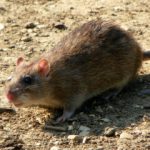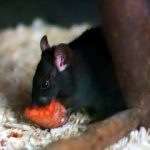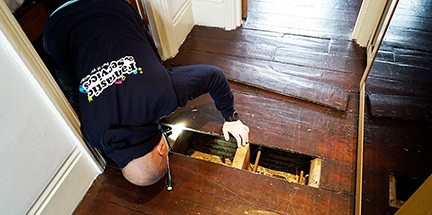Rats
 Rats are among planet Earth’s ultimate survivor species. They scavenge, hunt, hide, possess remarkable intelligence and are a very important part of the natural habitat. Since the dawn of mankind, the rat population has been booming all over the world because humans provide the best living conditions for the rodents. Because of that, property owners are in a great need of pest control once they realize they have a rat infestation.
Rats are among planet Earth’s ultimate survivor species. They scavenge, hunt, hide, possess remarkable intelligence and are a very important part of the natural habitat. Since the dawn of mankind, the rat population has been booming all over the world because humans provide the best living conditions for the rodents. Because of that, property owners are in a great need of pest control once they realize they have a rat infestation.
Norwegian rat

The brown rat (also called Norwegian rat) is the most common household rodent in the entire world. It grows up to 40 cm in length and its tail is usually shorter than its body. They produce between 5 and 10 rat babies per litter and have between 3 and 6 litters a year. The young reach sexual maturity about 10 weeks after birth.
Image by: Peter O'Connor
Black rat

The black rat is smaller than the brown rat, it grows no more than 25 cm in length. However, its tail is longer than its body. It has a pointed nose, large ears and a slender body. Just like the brown rat, it produces between 5 and 10 baby rats per litter and between 3 and 6 litters a year. The young reach sexual maturity when they are 10 weeks old. The black rat climbs a lot, doesn’t like to burrow and it’s rarely found outdoors. It eats less than the brown rat.
Image by: Liftarn
Habitat
Despite the brown rat being called a Norway rat in some parts of the world, it does not originate from Norway. It was introduced in the Nordic country after the name Rattus Norvegicus was already popularised. Scientists speculate the Norway rat originates from China or Eastern Mongolia. During the Middle Ages, they spread to other parts of the world.
The brown rat is cosmopolitan and lives on every continent. Antarctica was declared rat-free in 2012 when the population of brown rats on Rat island was eradicated. They were introduced to the island after a Japanese shipwrecked nearby. There are several other rat-free zones in the World, namely Iceland and Alberta, Canada.
Diet
As an omnivore, the Norway rat has a rich diet. It consists of but is not limited to, cereals, seeds, grains, nuts, meat, pet food, eggs, dairy products, and even chocolate. There are just a few foods they avoid—raw beets, raw celery, and peaches. Rats get their food from both outdoors and indoors locations.
Urban tales of rats preying on cats and dogs are exaggerated. Although they are omnivores, they are not keen on hunting. Rats are scavengers and will attack only when starving. However, it is not unlikely for a rat to attack and potentially kill a dog or a cat in self-defence.
Read more: What do rats eat?
Behaviour
- Rats are social animals and live in colonies. A wild rat colony can number in the hundreds. It is rare for Norway rats to nest indoors. They prefer underground burrows from where they enter buildings in search of food, for instance, your garage.
- They are nocturnal and rarely go outside in the daytime. Unlike what the majority of people believe, they are not aggressive and prefer to shy away rather than engage in a battle. Yet when threatened, they become vicious fighters.
- Rats reproduce rapidly. A rat litter consists of up to 24 pups. Their pregnancy is just 28 days long.
- The Norway rat can jump up to 70cm and can swim over long distances.
- They have an acute smell and hearing which allows them to sense any disturbance. However, they are colour-blind and have poor vision.
Health Hazards
Rats are well-known disease vectors and carry numerous infectious pathogens. The list includes serious illnesses such as typhus, Weil’s disease, rat-bite fever, Q fever and leptospirosis. They contaminate food and water sources with saliva, droppings and urine.
The disease most commonly associated with rats—plague—is not carried by Norway rats. It is transmitted by fleas leaving an infected black rat and attacking a man. Black rats are now extinct in the UK but can be found throughout Europe. They were driven out of Britain by the Norway rat. Black rats also spread Hantaviruses.
However, rats are one of the few mammals not known to spread rabies. Although there are incidental reports of rats infected by the disease, there are no known cases of rat-to-human rabies infection. Rats are also extremely resistant to the rabies virus.
Read more: Do rats bite people?
Damages
Norway rats cause huge harm to the world economy. They cause structural damage to a building and can cause a fire by chewing on a cable. They can also destroy flood defences, bridges and security fences.
Rats feed on wheat and rye. Tons of harvest are destroyed each year due to disease contamination, caused by them. They also infect domesticated animals.
Signs of rats
- Chewed items – Like mice, rats have incisors that never stop growing. Thus they need to chew onto something hard on a regular basis – cables, woods, even pipes.
- Droppings – the shape and size of black olives. Unlike mice, rats are a bit more protective, so they have better hiding skills and don’t want to be noticed. If you hear noises, see chewed cables, but don’t find droppings, it’s probably rats, not mice.
Read more: How to identify rat droppings? - Smears – rats have poor sight, that’s why they follow the same routes while moving. Constant moving on the same tracks will leave dark marks on surfaces – that’s called smears.
- Noises – rats can climb walls, so you might hear scratching noises behind walls.
- Footprints – you might see footprints on dusty places (basements, attics). Like any other animal, rats leave their prints.
Read more: Signs of a rat infestation.
Rat prevention: How to Deter Rats
Prevention is the best medicine. If you don’t have rats right now, or if you just managed to remove the nightmare from your house, you need to make sure that no rodent enters your property again. To do this, there are a few important steps to follow.
- Fill holes and gaps in your property structure. The most common reason people get a rat infestation is holes and cracks in the walls or ceiling. Blocking the nasty critters' way in is the first and most important step in rat prevention.
- Get a pet. A cat or a dog won’t be useful if you have a full-blown infestation, but it’s true that they are a good prevention method. Rats wouldn’t dare to nest in a property where their predators lurk.
Read more: Where do rats nest? - Keep your home clean. Cleaning up a house doesn’t simply mean sweeping every day. Rats will not come knocking on your door, just because there’s some dust. Like any animal, they will come, if there is food laying around. Don’t leave uneaten food on the table, or dirty dishes in the sink overnight. Pet food is also a big attractor, and so is the garbage bin.
Read more: How to prevent a rat infestation? How to get rid of rats?
How to deal with rats inside your home
 Rat control must focus not only on exterminating the population but on preventing the re-entry of rodents inside your property. There are several different methods of rats control.
Rat control must focus not only on exterminating the population but on preventing the re-entry of rodents inside your property. There are several different methods of rats control.
1. Poison is the most effective at killing rats.
2. With traps, there is no risk of dead rats in hidden locations. In order for a trap to be effective, it must be placed on the path of the rats.
3. Another important aspect of rat control is preventing future access. All points of entry must be sealed to avoid re-infestation. These include holes in the walls and attic, gutters, pipes, structural gaps, and even roof tile intersections.
Looking for professional rat control?
Book an inspection nowWe only aim to provide some useful facts about rats. Anyway ,we don't provide any medical advice.


